by Winding Pathways | Aug 30, 2016 | Mammals, Nature, Pests
A long-ago children’s story began something like this, “There is a mouse in my house. It is a very nice mouse. It has a long, long tail and shiny eyes. It pops out of its hole and runs. My mother likes the mouse, but she says, ‘A mouse does not belong in a house.’”
Well, guess what, a sure sign that fall is approaching is “a mouse in the house.” These tiny mammals realize that shorter days and cooler temperatures beckon winter. Finding a safe warm place to live with an abundance of food helps them survive the tough season.
At Winding Pathways we expect mice to appear with the first cool weather in late August or September. Once in a while we have seen one scurrying across the floor, but more often we have found their tiny black droppings on counters. Sometimes we have heard them scurrying about an upstairs closet.
Two types of mice inhabit houses. Both gobble birdseed and will eat nearly anything people do. They capable of doing damage and possibly spreading disease.
The common house mouse is a gray mammal native to the Old World that is now found everywhere people live. They like houses, barns, garages, and sheds but are rarely found far from buildings and live indoors all year round.
Several species of native mice live outdoors most of the year but move inside each fall. These are normally called deer or field mice and are beautiful tiny mammals with shiny eyes and white feet.
They store food, while house mice don’t. Find a pile of sunflower seeds in a shoe and the culprit is a native mouse.
We love wildlife but don’t tolerate mice in the house. So, each fall we plan an eviction campaign.
Here’s how we reduce mouse problems at Winding Pathways:
- Tighten up cracks and holes. Every fall we arm ourselves with a caulking gun and can of expanding foam and inspect the house from the outside and inside. We fill in any likely entryway for mice, which can squeeze through tiny spaces. Caulking also helps keep insects and cold air out of the house.
- Set up a trap line. Old fashioned mouse traps efficiently catch and instantly kill mice if set properly. Here are some effective trapping tips:
- Buy many traps and set them all at once. Try to catch all or most mice in one night, rather than just setting a few traps.
- Bait traps with peanut butter and set them with the trigger side against the wall where mouse evidence is noticed. Mice tend to run along walls, rather than across the interior of a room, so trapping success is usually best near a wall.
- Set traps in tandem. Instead of just setting one trap here and there along a wall double or triple them up side by side, again with the trigger side facing the wall.
- We don’t use poison. It seems cruel and inhumane and poisoned mice tend to die in inaccessible places and stink to high heavens.
- Encourage predators. We don’t have a cat but encourage raptors to visit our yard. They work year round reducing rodent numbers.
- Mice are encouraged by food. We keep all food in sealed metal containers or in the refrigerator and wipe up any spilled food. Wild bird and pet foods are loved by mice. Keep them in a metal can with a tight lid and dump out the dog or cat’s food dish in the evening so there’s nothing for nocturnal mice to eat.
Mice are fascinating animals that play an important role in nature, but they belong outside. It’s probably not possible to entirely eliminate them from a house but simple techniques will encourage them to stay outdoors.
by Winding Pathways | Aug 26, 2016 | (Sub)Urban Homesteading, Garden/Yard, Nature, Trees/Shrubs

A Guest Column by Jackie and Peter Hull
When we first moved to Virginia fifteen years ago, we had no idea that the entire state was in a drought which had been ongoing for a couple of years. In order to help water the garden we wanted to grow, we decided to construct rain barrels. We had seen the master gardeners of Bedford, VA, demonstrate how to put them together.
To begin we bought four 55-gallon barrels from Southern Flavorings for $10 apiece. The faucets and pool filters added another $15 bringing the total to $25 a barrel as opposed to $75 to $100 a piece fully equipped from a company. When we modified our barrels a few years later no longer using pool filters, we had to add the cost of screening and bungee cords which made a total of $30 a barrel.
In outfitting the barrels Peter cut circular holes in the top of each barrel and fitted them with pool filters to catch debris and give an access to help clean out the barrels in the fall. About five inches from the bottom of the barrels he cut holes just large enough to insert the faucets and rings. To help seal this entrance he used caulking compound. He modified the down spout of the rain gutter to arc over the pool filter to catch the rain. The remaining barrels sat adjacent to the first barrel and each was attached to the other with a short piece of PVC pipe that was inserted from one barrel to the next so the water would flow filling each barrel. The last barrel had an overflow spout at the top pointing to the ground so once it was filled the rain water could dribble to the ground.
As we added more barrels, Peter changed from cutting holes in the top of the barrels to cutting the entire top off and covering with plastic screen and using a bungee cord. Fortunately, the top of each barrel has a lip so the bungee cord fits snugly around the barrel holding the screen securely in place. His thinking was this would make cleaning the barrels much easier. It is. To keep mosquito larvae to a minimum, we put a mosquito donut into each barrel. The screening also protects the birds which was initially my concern when he decided to cut the tops entirely off.
All the barrels sit on benches that we constructed so that the water is gravity fed to the garden through a number of hoses. Over the past several years we’ve added more barrels for a total of eleven rain barrels containing 55 gallons each for a total of 550 gallons of water collected from the metal roofed house and garage. This year we’ve emptied them twice over the growing season as we’ve had alternating rain and warm sunshine.
Winding Pathways Notes: Some people may prefer to buy rain barrels ready to install. Most large home improvement stores sell barrels as do many nature centers. Also, be aware that in some arid areas harvesting rain water is in dispute or illegal unless a person owns the water rights. These laws are changing as times and uses change.
by Winding Pathways | Aug 20, 2016 | Bugs, Flowers/Grasses, Nature
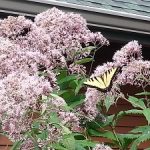
Joe-Pye Weed can grow to great heights and is a favorite of butterflies and other pollinators.
Carol Lampe shared these pictures and write up of her wondrous yard and the pollinator action on Joe-Pye Weed (Eupatorium purpureum). This is a particularly valuable fast food stop for migrating butterflies as it lasts into autumn. We have found it a bit difficult to start and then it takes off! Give it plenty of space and enjoy the butterflies.
“Here is a butterfly twofer from my flower bed. In the forefront you can see the female Eastern Tiger Swallowtail (Papilio glaucus) sitting on a Joe-Pye Weed. There were several Swallowtails out there that day.
“Joe-Pye Weed is an herb and the butterflies really seem to like it. Native Americans, and later, white settlers, made much use of Joe-Pye Weed. Teas of the roots or tops were used as a diuretic, as well as for rheumatism, gout, fevers, diarrhea, respiratory disorders, and even impotence. Modern science has not confirmed their efficacy.
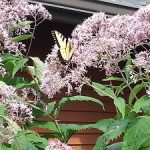
Sipping nectar on Joe-Pye Weed.
“Tucked toward the back is a Red Admiral (Vanessa atalanta). The males are territorial and many times can be found in the same location day to day.”
Thanks, Carol, for sharing your wondrous yard with Winding Pathways.
by Winding Pathways | Aug 8, 2016 | Bugs, Flowers/Grasses, Nature, Reflections/Profiles, Wonderment
Here is a story fro Gordon and Nancy Bena about their interest in Monarchs, their chrysalis find and how they began to tend their property differently to encourage insects.

Adult butterflies need nectar to sip and plants to rest on.
“We went to the presentation given at the library that told us the fate of the Monarch. With that we were very careful not to mow down any Milkweed plant that we saw in the yard. We also planted Butterfly Weed and I did not mow any of the clover down this year.
“This particular plant where we found the chrysalis was kind of blown over from one of the wind storms and we put a tomato cage around it to hold it up so the caterpillars would have something to munch on. When I went down to get the mail the other day, I stopped to check that the plant was still standing. This is when I found the chrysalis. I went around to the other plants but I’m afraid that this is the only success story I found so far.”
Thanks, Gordon and Nancy!
by Winding Pathways | Aug 3, 2016 | Bugs, Nature, Pests
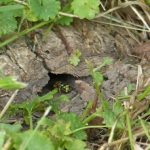
Yellow Jackets often create a nest in the ground under bark.
As Marion was looking out the window recently she saw Rich abandon the lawn mower and race across the yard swatting and jumping as he ran. What was going on?
He’d pushed the mower up close to wood mulch around a tree and disturbed a Yellow Jacket nest. They boiled out of their underground home and attacked. Rich was stung five times as they chased him across the yard.
Many people have unpleasant encounters with this aggressive insect every year, especially in late summer. Their stings are painful and it’s a rare and fortunate person who only gets stung once. Multiple stings are normal. First, get away from the nest and alert everyone else around about the nest. Then, put ice on the stings to keep swelling down. Watch for and treat more serious allergic reactions.
The life history of Yellow Jackets is interesting. Many species live in the United States. Some, like the German yellow jacket, are exotic while others are native. Most have the familiar yellow and black pattern, although a few species may be black and white. Only the queen overwinters, and in spring she makes a nest that’s usually underground but can be found in other locations. She’s an egg laying machine. By late summer the colony can have thousands of members.
This insect is generally beneficial. Adults eat a wide array of fruits, meat, sweets and insects but normally they feed their larvae insect parts. Although they consume pesky insects, they often forage in trash cans and they love picnics. A definite problem because there is nothing beneficial about being stung many times. The experience can be traumatic to a child.
Yellow jackets don’t go out of their way to sting, but they do readily attack anything they believe threatens their home. Generally they won’t attack a person walking quietly in the area. But anyone who disturbs the leaves or sticks near their entry hole will be chased by dozens of yellow jackets as they boil out of their nest and attack.
If the nest is in a place with much human traffic, it is prudent to destroy it. That requires pinpointing the entry. To find it, carefully approach the area where the nest is suspected. Look for a small hole, often under a piece of wood, with insects coming and going. Avoid making noise or disturbing leaves, mulch, or wood. A pair of close focusing binoculars can aid in the search. Once the entry is located follow these steps:
- Wait until after dark when all insects are down in the nest.
- Approach the entry hole with a flashlight, a spray can of wasp killer, and a piece of carpet.
- Spray the poison down the hole and cover it with the carpet to keep fumes and insects inside.
Remember to only destroy a nest if the insects pose a stinging threat. Otherwise leave it alone for these beneficial, although cranky insects to live.
A side note is that several colleges and universities like Georgia Tech and Black Hills State University sport the Yellow Jackets as their mascot. Appropriate Buzz and Sting!
by Winding Pathways | Jul 29, 2016 | (Sub)Urban Homesteading, Flowers/Grasses, Nature, Reflections/Profiles, Wonderment

A brilliant harbinger of summer with a long lasting biannual bloom.
Many years ago word came that a dear friend had tragically died in Utah, over a thousand miles from our Iowa home. With deep feelings of grief of the loss of a vibrant young woman I (Rich) felt the need to “do something for her.”
We were in the process of restoring prairie to a bare patch of ground on recently purchased piece of land at the Indian Creek Nature Center. A bag of prairie wildflowers perched against my office wall caught my eye. I grabbed the bag, walked to the meadow and scattered the seeds in the woman’s honor.
The seeds thrived. Now, a dozen years later they grace the prairie with color and restore memories of my friend. We shared this story with our friend’s husband who was moved. So, we decided to share our way of honoring and memorializing ones dear to us.
Planting flowers, shrubs, and trees in a yard or park is an outstanding way to reduce grief, maintain memories, honor someone, and make our world healthier and more vibrant.
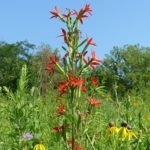
What a stunner!

Sipping nectar
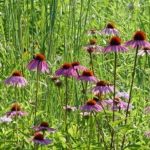
Purple Coneflowers add color to a prairie.









